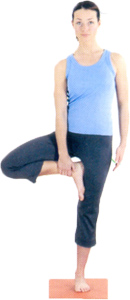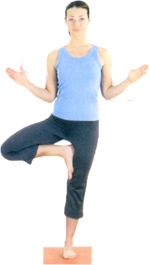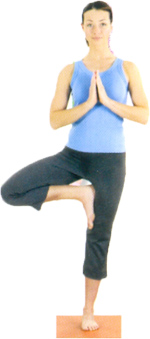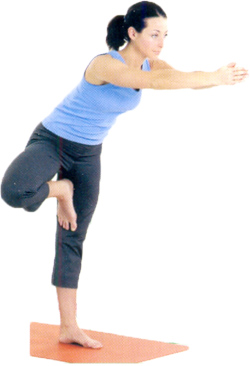Understanding the pose “Tree. Treatment of the nervous system. Doing exercises for improvement.
In many cultures, trees are endowed with sacred and symbolic meaning. From the earliest times, trees have provided for people materially, providing them with fruits, shade and timber. From a spiritual point of view, trees were and are considered as
"bridge" between the earthly and heavenly (lower and higher) worlds. The Chinese believe that the spirits of the gods reside in trees, and according to Scandinavian myths, people were created from wooden figures.
Remember that asanas become yoga only when they are done with full awareness. Vrikshasana Tree Pose by Pedro Kupfer Vrikshasana Tree Pose is one of the first asanas of Hatha. The practice of standing on one foot, in balance, exposed to the elements of nature, was part of the yogic practice of plant rishis, as evidenced by the thousand-year-old sculptures and panels in temples or sacred places in India. Translation of the name of this pose: Vriksha = tree, asana = pose; wooden pose.
Correct your gaze to a point ahead. Get lost right leg and press the sole of that foot onto the upper left thigh, leaving the knee down and to the side. In this first variation, you can raise your arms to heart height or above your head. Optionally, you can leave the back of the foot embedded in the left groin. If you want, from now on keep your leg up right hand and raise your other hand vertically. In both variations, you can still lean your body forward with your hands on the ground, at the sides of your left leg.
Tree roots
The Tree Pose uses this deep symbolism. Where there are deep and extensive roots, a hard and strong trunk can grow, giving life to sun-loving branches and ultimately fruits. When performing Tree Pose, you must maintain balance by standing on one leg, while placing the foot of the other foot on inner part hips of the first leg. The bent knee should be fully rotated to expose your hips.
Activate the leg, knee and leg supporting the body. Point the spear down to the heel of the base foot and pull up. Take the breath to the side ribs, lifting the brisket and closing the space between the lower ribs at the same time as the solar plexus. These exercises establish a deeper connection with the Earth. Hold the exercise for one minute. Place your hands in the center of your chest and keep your hands in your hands. The legs in this form represent the roots of the tree. Imagine your spine as if it were a tree trunk. feel the energy rising up your legs.
Prayer Pose
Hands should be folded in a prayer position (palms together) and raised above the head. Your body, as it were, becomes a tree: the foot standing on the ground is the base of the tree, the body is the trunk, and the arms are the branches. The Tree Pose is not physically difficult, but requires balance and concentration.
Tree Pose will help you focus on inner balance and serious spiritual growth.
Then proceed in exactly the same way, repeating this asana on the other side: bend your left leg, insert your leg into your thigh or groin, help with your hand and check if their backs are upright. Breathe deeply and consciously. Think about the hardness and strength of wood. Also, develop the ability to see yourself and other people as if they were trees: each in a different way, each unique in their individuality. Pedro Kupfer This is a very intense spinal twist and is very effective for toning the musculature and internal organs at the bottom of the trunk.
Benefits of Tree Pose:
The Tree Pose brings many benefits to the person doing it, in particular, it provides mental focus and physical balance.
While assuming a pose, focus your eyes on a point in front of you. This will allow you to focus on the pose being performed.
- Performing the “Tree” pose will help you feel inner peace and balance. Whatever physical balance you achieve will spill over into your mental and spiritual state. If Tree Pose seems too difficult for you, try to figure out which areas of your life need to be balanced.
-Pose "Tree" will help streamline and focus the mind.
- Tree Pose strengthens the muscles of the legs, shoulder girdle, hips and lower back, and in addition increases the flexibility of the legs and hips.
Translation of the name of this pose: Marichi = the name of the Vedic rishi, the son of Brahma; "Position of Marichi". Variation of Marichasana with one foot in Padmasana. Assemble this pose as follows: while sitting, bend one leg and place the sole of the foot on the floor, parallel to the outstretched leg. Keep as far as possible the ipsilias on the floor. Inhale while pulling vertically as if you want to touch it with your head on the ceiling. Pass the hand from the side of the raised knee. If you cannot bring your hands together behind your back, place your hand on the floor behind the spear and let the other hand reach out to your knee.
Performing the Tree Pose step by step:
Practice Tree Pose to flex the hips and strengthen the limbs while achieving concentration and concentration of consciousness.
1. First, stand up straight, feet together, shoulders relaxed, arms along the body. "Grow" your feet into the ground and try to concentrate on the feeling that you are a strong and tall oak.
Only later, but still holding the space in the abdomen and lumbar region created by the pull, does he slowly turn around. Look over your shoulder, opposite your elongated leg. In this posture there is a tendency to step back, squeezing the rotating flank. Make sure your shoulders are the same height. Look for signs of energy circulation in the lower abdomen and solar plexus.
A very important note: make this turn very carefully. Marichyasana A, the bend of the wise Marichis. Pedro Kupfer This is a very effective spinal flexion of the tone and strengthening of the internal organs, as well as the activation of the vital forces that circulate in the region of the trunk, prana and apana vayu. Translation of the name of this pose: Marichi = the name of the Vedic rishi, the son of Brahma; "Kiss Marichi".
2. Raise your right leg and use your hand to place your foot on the inner thigh of your left leg. Keep your left leg straight and your right knee out to open your thigh.

3. Focus on a point directly in front of you. This will help you keep your balance. When you're ready, stop holding your leg with your hand and straighten your head, neck, and back, making sure you don't lean forward.
Assemble this position as follows: while sitting, bend one leg and place the sole of the foot on the floor, parallel to the outstretched leg, and one foot away from the inside of the thigh. Inhale as you pull vertically and exhale as you lean forward. Without squeezing the back of your head, pull your chin toward your leg rather than trying to get down on your outstretched leg. There is no need to meet face to face. Focus more on pulling towards the foot than going down at any cost to the knee. If necessary, slightly bend the extended knee.
Shoulders are parallel to the floor. Avoid squeezing the front of the spine by always prioritizing traction and space between the vertebrae. Forget to come with your forehead on your knee if it's not easy for your body. Please note that the gang is active. Repeat the other side with the same constant as you come back. By maintaining this type of posture, the body tends to relax and tone itself.

4. Slowly bring your palms together in front of your chest in a prayer pose. Breathe calmly, concentrating on maintaining balance.

5. Slowly raise your arms above your head. Straighten your elbows, inhale deeply, holding your breath for 30 seconds. Gradually stretch for 3-5 minutes.
This relaxation benefits the brain and central nervous system. The legs are parallel to each other, aligned along the outer edges. The arches are raised and active, firmly supporting the outer parts of the feet. Avoid hyperextension of the knees. Keep them slightly bent if necessary. Note that the thighs are parallel to the floor. Activate shrink and boost pelvic floor. The barrel is relaxed in this thrust. Keep in mind the space between the iliac bones and armpits. Notice the internal rotation of the hips.
Keep your tailbone up as far as possible. The shoulders are turned back to the shoulder blades and parallel to the floor. D. thumbs up. Keep the base of the neck relaxed and away from the shoulders. Stay breathing for five cycles of each variation, or choose one of them and breathe twenty times.
6. When you feel confident in your balance in Tree Pose, lower your arms in front of you, keeping your elbows straight and palms together. Lean in slowly.

7. Continue bending until your hands touch the floor and your back is parallel to the floor. Hold this position for 15-30 seconds and then return to Tree Pose.
Be aware of the energy that circulates at the level of your heart. Rear leg facing forward at a 45 degree angle to the other, if possible. Align your heels with each other. Don't overload your knees. If necessary, keep them slightly bent, especially in front. Do moola bandha before descending. Trace the shaft vertically, create space in the abdomen, and only then descend. The trunk is active but relaxed on the leg. The shoulders are turned back towards the shoulder blades. Keep your face relaxed.
Be aware of the energy in the heart. Pedro Kupfer Translation of the name of this pose: Janu = knee, shirsha = head; "The position of the head to the knee." The starting point of this pose is identical to the starting point of ardha-baddha padma pashimottanasana. The difference is due to the placement of the dorsal leg of the bent leg, which stays on the floor rather than being at the top of the thigh. The shoulders are at the same height, parallel to the ground, and both sides remain elongated with the same intensity. There is no need to come face to face.

Tips for maintaining balance:
Performing the Tree Pose requires the distribution of weight on different parts of the foot: heels, toes, toes and sides. The ability to maintain balance is given by nature, but with age and in the absence of practice it is lost. Practice Tree Pose and your balance will return to you. Always perform Tree Pose with bare feet as this will provide the best contact and traction with the floor.
-Keep calm while exercising and you will be able to keep your balance.
Focus more on pulling towards the leg. Keep the bands active at the base of the trunk. Soften appearance and relax your forehead, neck and jaw. In conclusion, repeat everything in the same way and with the same intensity, on the other leg. Stay at the same time. Let's pay attention to the flow in the direction between the throat and the heart.
Make sure both hubs are firmly on the floor. Place the back of one leg on the inside of the opposite thigh. If the bent knee is touching or close to the floor, continue from there. Make sure your shoulders are parallel to the floor. Don't push your knees too far. Notice if your shoulders are parallel to the floor.
MAKING PROGRESS
If the pose presents any difficulty, you should not increase the load too quickly. Start by lifting one leg and keeping your balance in that position. Perfect this pose before moving on to the next step - placing the foot on the inner thigh of the second leg. Feel confident and balanced in this pose for 1 minute before attempting to close your eyes or assume Tree Pose. Once you succeed in this, take the following steps.download dle 10.4 movies for free
Worry more about moving forward towards your leg than dropping your knee or touching your face. Center the awareness of the birth and the relief that the posture creates in the shoulders and back. Pay attention to the energy circulating in the throat area. Upavista konasana Pedro Kupfer Translation of the name of this posture: Upavista = sitting, kona = corner; "Angular position, sitting."
If you put too much pressure on your legs, you will lose stability or safety, and you may damage the ligaments or tendons of your limpet-femur joints. Keeping your hands on your knees, pull your body up vertically before descending. Exhale, run your hand along the lower leg until you get close to the legs or ankles. It is very important to maintain perineal elevation and lower abdominal contraction while remaining open at the same time. Make your belly skin smooth. Drive the tailbone from behind, keeping the spine aligned with the angle of the body or keeping the head close to the ground.
At first glance, it seems to be a very simple and inconspicuous pose for beginner yogis. Its implementation does not require any titanic efforts, acrobatic flexibility or preliminary preparation of the body. But at the same time, this is one of the most important asanas, which have been of great importance since the formation of yoga. The fact is that with its simplicity, Tree Pose gives so much useful to man that its daily performance of only three minutes on each side can bring into balance all aspects related to the internal state of a person: bodily, mental, emotional and energetic. The benefits of performing this asana in terms of their properties can be compared, for example, with the properties of garlic - an unpretentious product, the spectrum of action of which is very, very large.
Keep your fingers up, not letting them turn too far forward. If necessary, bend your knees as far as possible for protection. hip joint. Pay attention to the movements of prana in the lower abdomen, navel and solar plexus. If you wish, you can raise your legs from this asana, preferably extended, but you can bend your bent knees and raise your face to the sky, as shown in the figure below. Work on your funds.
Avoid tension because this asana is already strong. Urdva dhanurasana Pedro Kupfer Translation of the title of this position: Urdva = high, up, dhanura = bow; "High position of the arc." Lie on your back on the floor, parallel to your legs, leaning against your buttocks and parting hip-width apart. Place your hands on the floor with your fingers. Rise up, exhaling on the palms and plants. It is very important to develop stability in this position. Establish a solid ground connection. Feel the soles of your feet and palms, literally hugging the floor.
So, let's look at five main advantages.
1. Healthy body
Correct execution of the asana allows you to straighten your back and “put” the vertebrae in place. When performed regularly, the muscles of the lower leg and foot relax, which contributes to a freer circulation of blood circulation in the lower part of the legs. This is especially helpful for those who often feel cold and numb in their feet. In addition, this asana improves the metabolism and functioning of the gastrointestinal tract, liver, kidneys and gallbladder, and, accordingly, increases the efficiency of metabolism in the body. When performing the Tree Pose with arms folded in front of the chest, the chest opens, the shoulders turn, and space is freed up for deeper breathing. With arms raised up, work is carried out with shoulder clamps, which, with regular and correct practice, become less rigid, and ideally, they are completely eliminated.
Body weight should be evenly distributed between arms and legs. Relax your buttocks in this pose so as not to compress your lower back. The tailbone is facing the knees, not straight to the floor. Avoid creases in the lumbar skin as this is a sign of compression in that area. Feel the energy from the floor as you move up your legs to the trunk. Pay attention to the movements of prana in the solar plexus and heart. Do this position very carefully. Avoid staying in it for too long. If you feel pain in your lower back, stop practicing it until you know exactly what the pain means and how you can manage it.
2. Stability and balance
Tree Pose is one of the best asanas for training the vestibular apparatus. The practice of asana allows you to develop inner balance, the ability to maintain balance, as well as become more stable and strong. It is also a great asana for grounding and centering.
Shirshasana Pedro Kupfer Translation of the title of this position: Shirsha = head; "Pose over the head." Proceed as follows: start with kurmasana, on the heels, lying on the hips. Inhale as you lift your hips, tiptoe towards your head. Maintain firmness at the base of the posture, formed by the neck, head, elbows and forearms, and the outer parts of the wrists and hands. Release the weight on your neck and head, supporting your forearms, arms, and shoulders.
Watch if the gang is active and notice if breathing is not forced. If it gets superficial or difficult, go back from inverted. Be responsible for your own health and physical integrity. Look for signs of energy circulation in the neck and head. Shalabhasana, the position of the grasshopper Pedro Kupfer. This pose is ideal for strengthening the lumbar area and back muscles. A strengthened and resilient lumbar square is necessary to maintain the integrity and health of the vertebrae and discs of the lower torso.
3. Calm mind
In those moments when a lot of unnecessary thoughts are spinning in the head and it is impossible to concentrate on something important or just relax, it is enough to perform this asana for 3 minutes how the mind becomes absolutely pure and calm. In addition, the structure of this asana is such that it will be impossible to perform it without sufficient concentration, so the development of a deeper concentration of the mind will be an additional plus, which, of course, will always come in handy when solving important issues in a flood of information.
4. Treatment nervous system
Concentration, balance and grounding are the main tools to calm and normalize the nervous system and counter stress. All these three components are present when performing the asana. In addition, in Tree Pose one straightens and relaxes. sciatic nerve, and it also has a very beneficial effect on the state of the nervous system. Try this asana when you are under a lot of stress and you will see how much calmer you will become.
5. Balance of energy flows
Well, what is the practice of yoga without affecting the flow of vital energy! And this asana when working with energies is very special.
First, it builds the main energy channels that make the chakras "work" more efficiently. This contributes to free energy exchange, a surge of new strength and an increase in mood.
Secondly, it balances all five elements:
- ground through the support and increased load on the foot;
- water due to freer circulation of fluid (blood and lymph) in the body;
- fire, since willpower is required to hold a pose;
- air by opening the chest, allowing you to breathe more freely;
- ether, interaction with which occurs through raised hands and concentration.
The first and second factors contribute to the appearance of the third - a stronger and more radiant aura.
Performing the Tree Pose allows a person not only to get a large number of energy, but also to use it more rationally by increasing the level of awareness achieved through concentration, balance, mental stability and calmness of the nervous system. Is this not the desired result from the practice of yoga?
Julia Klyus is a Kundalini yoga teacher, psychologist and consultant on personal development and quality of life.
Photo: bethpedote_ashtanga / instagram.com




